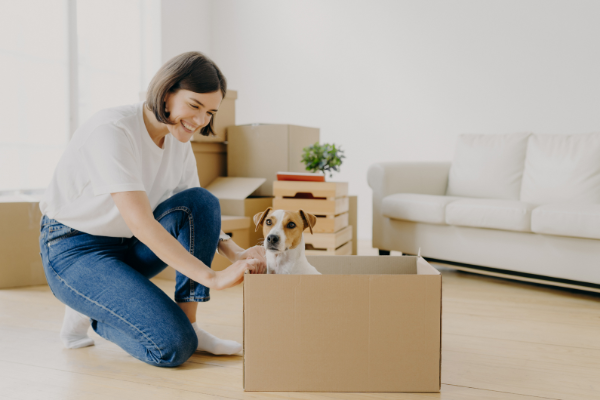Tips for Moving With Pets pt1: Preparing to Move
If a move is imminent be sure you have a plan in place for making the process as painless as possible for your furry (or feathered or scaled) friends. As stressful as a move may be for us it is even more so for our pets, who have no idea what is happening or why. Going into a move unprepared will likely result in health and/or behavioral issues for even the most easygoing pet. Thankfully there are a number of things you can do before, during, and after your move to help your pet adjust.

Preparing to Move
Find a Pet Friendly Home
Moving your pet safely begins long before a single moving box has been packed. It begins when looking at new homes. Be sure to assess each house you look at for whether or not it will be pet friendly.
- Visualize where your pet’s food and water will go.
- Is there a draft-free space for your small animal cage?
- Is there space for your pup to run?
- What about vertical space for your kitty to prowl?
- Take a walk around the neighborhood and take note of any dogs that seem aggressive or are left unattended.
Do Your Research
Another key factor in assuring your new home will be pet friendly is to do your research about the laws and regulations in your new city and state. Exotic pet owners are more used their pets being regulated but there are also communities in the United States where Pit Bulls and other "bully" breeds are banned. You'll also want to read the pet requirements in your lease or association documents before signing on the dotted line.
Get Your Pet Ready
Once you’ve chosen the perfect new home for you both it's time to begin conditioning your pet in preparation for the move.
- Get your pet used to moving boxes in advance by placing a supply of them in your home. Allow pets to sniff and explore them until they’re old news. Not only will this reduce pet stress while you pack, but it will hopefully help protect your boxed possessions from curiosity.
- If your pet isn’t already familiar now is the time to begin some level of crate training. A very basic method is to simply begin creating a positive association with the crate. You can begin by feeding your pet in their crate, then begin closing them in to eat. If they receive treats, they get them in their crate. And when crate time is over follow up with treats and playtime. Need more detailed information on crate training? Check out this Article on Cat Crate Training or this resource from The American Kennel Club.
Keep Your Pet Calm and Happy
As you continue the packing process there are 2 more key factors in keeping your pet calm and happy.
- Routine is key. Animals (especially dogs and cats) are creatures of habit. Drastically changing their schedule will likely increase their anxiety. Do you always come home from work and give your cats treats? Even if you aren’t going to work today, hand out treats at the normal time. And, even if your to-do list is a mile long don’t skip the evening game of fetch.
- Keep your pet entertained and well-exercised. Even under normal circumstances, a bored or hyper pet is unhappy. In their article,11 Tips to Make Your Move With Pets Easier, Einsteinmoving.com writes, “Remember that a tired pet is a calm pet.” Try adding brain games into the routine and if you are short on time, hire a dog walker or pet sitter.
Visit Your Vet
Especially if you are moving to a new city or state you are going to want to add a visit to your pet’s veterinarian to your moving to-do list. Not only is your vet an expert on all things animal health and happiness, but she also knows your pet and will be a great resource for ways to ease the transition. Be sure to cover the following topics during your visit:
- If you need to find a new vet, ask your current provider for a referral in your new city.
- Ask about any additional tests or vaccinations that may be required if moving out of state.
- Make sure all vaccinations are up to date and obtain a copy of your rabies certificate and your pet’s medical file for your new vet.
- Get a supply of any medications your pet is on in case it takes a bit for you to get to see the new vet.
- If your pet is especially susceptible to anxiety or motion sickness, chat with your vet about tactics or supplements to help.
Guard Against Lost Pets
Every year 10 million pets are lost in the united states according to the American Humane Society. According to Joe Robison of movebuddah.com, 60% of the time if a microchipped pet cannot be reunited with its owners it is because of outdated contact info. Don’t let this be you. No one plans to have a pet get lost or run away, but during a stressful situation like moving, the likelihood of that happening is higher than ever. There are a few simple steps you can take before moving day to guard against this tragedy.
- Make sure your pet’s microchip is properly registered and update the information with your new address and phone number.
- Update your pet’s tags with your new address.
- Create a temporary travel tag to add to your pet’s collar for the move. According to movebuddah.com, this tag should include your moving dates, your final destination, and how to reach you.

The preparation phase of moving can be long, and stressful. Remember that your pet can sense that something is up so stay calm and before you know it, it’ll be moving day!
Looking for tips to make moving day go more smoothly or to help your pet adjust to their new home? This is part one of our three part series on moving with pets. Be sure to check back for part 2 and 3.






